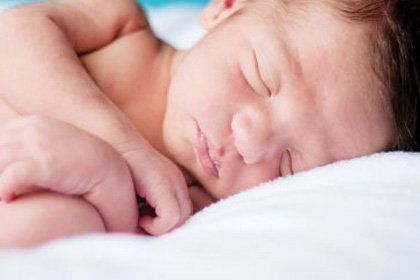 Choking sounds startled Mercer Island mom Karen Morgan-Frazier awake. She flipped on the light and found that her 4-week-old son, next to her in her bed, was rigid, off-color and unresponsive. She rushed him to the hospital, where doctors told her he was suffering from reflux. He had spit up and was choking on the contents.
Choking sounds startled Mercer Island mom Karen Morgan-Frazier awake. She flipped on the light and found that her 4-week-old son, next to her in her bed, was rigid, off-color and unresponsive. She rushed him to the hospital, where doctors told her he was suffering from reflux. He had spit up and was choking on the contents.
Speaking with a social worker at the hospital, Karen asked whether co-sleeping could have caused something to go wrong with her baby. To the contrary, Karen says, “she thought we had saved him by co-sleeping, because what if it had happened in a separate room and I had not woken up?”
Co-sleeping has been getting some bad press lately. A study published in February in Pediatrics, the official journal of the American Association of Pediatrics, found that infant mortality rates attributable to accidental suffocation and strangulation in bed have quadrupled since 1984. The researchers concluded that prevention efforts should target those at highest risk and focus on helping parents and caregivers provide safer sleep environments. Based on this and related studies, the American Academy of Pediatrics recommends sleeping in the same room as an infant, but not in the same bed.
But some experts disagree. Renowned pediatricians Dr. William Sears and Dr. Jay Gordon vigorously defend sharing beds with infants, saying that when safety is prioritized, co-sleeping can have many benefits for children and their parents.
What is safe co-sleeping?
That’s actually the wrong question, according to Mary Ann O’Hara, M.D., M.P.H., clinical assistant professor of family medicine at the University of Washington. O’Hara runs Seattle Breastfeeding Medicine, where she specializes in the medical issues of breastfeeding. She says we should instead ask what constitutes a safe sleep environment. An adult bed need not be an unsafe sleep environment — and a crib is not intrinsically safe.
“It is very protective to sleep near your baby,” says O’Hara. “Isolating babies for sleep markedly increases the risk of SIDS. In the best studies, with safe furniture, unimpaired parents and babies who are not vulnerable, it doesn’t matter if infants and parents share a bed or not.” Rather, O’Hara worries that the blanket prohibition against bed sharing is sending the wrong message, and that it may even put more babies at risk by forcing parents to keep quiet about bed sharing. Some don’t feel like they can admit they are co-sleeping when it’s contrary to the recommendations.
“The overarching concern that we have is that programs that prescribe a complete prohibition on bed sharing don’t bother to provide information on how to co-sleep safely. They just say, ‘Don’t do it,’” says Kimberly Radtke, program coordinator for the Breastfeeding Coalition of Washington. “But the fact is that families report doing it anyway.”
O’Hara agrees. “I have heard clients say that since they can’t lie in bed with their babies, they will sit up on a rocking chair or on a couch, where they nod off to sleep.” This worries O’Hara far more than sleeping in a bed with a baby would. “Couches are found to have dramatic increase in risk of SIDS,” she says. A variety of studies back her up, including a 2005 study published in Pediatrics that found co-sleeping to be “extremely hazardous when adults sleep with an infant on a couch.”
The breastfeeding link
And O’Hara sees perhaps an even bigger issue: “Breastfeeding is one of the most important factors associated with infant health, including a reduction in the risk of SIDS,” she says. A National Institutes of Health study, published in March 2009, found that breastfeeding reduced the risk of SIDS by 50 percent. So, O’Hara reasons, health-care providers and public-health messages should do everything possible to help mothers who are trying to breastfeed. “A woman’s ability to fulfill her breastfeeding goals is associated with how much support she gets,” she says.
Many mothers find that breastfeeding is easier when they co-sleep with their babies. Some say they get more sleep when their babies are nearby and they don’t have to stumble out of bed to nurse a fussing baby at 2 a.m.
“Breastfeeding is not just a lifestyle issue,” says O’Hara. “There really is a preponderance of data that breastfeeding has tremendous health benefits. Telling moms not to co-sleep when it is so strongly supportive of breastfeeding undermines their ability to breastfeed and ultimately puts babies at risk.”
Freelance writer Tera Schreiber hasn’t slept a night without a child pressed against her for the past seven years.
For more information about safe sleep practices and SIDS, visit the Northwest Infant Survival Alliance's website.
9 Tips for safe co-sleeping
1. Sleep on a firm mattress. Natural fibers are best. Never co-sleep on a couch, waterbed, soft mattress, angled mattress, chair or furniture that has places where a baby could get wedged in or fall from.
2. Avoid alcohol. Parents who are impaired by alcohol, drugs or even intense sleep deprivation absolutely should not co-sleep. Find a way to catch up on sleep again before sleeping with your baby.
3. Keep babies away from tobacco smoke. Smoking parents should never share sleep space with a baby.
4. Keep baby’s temperature regulated. Babies don’t yet have fully developed internal thermostats; a baby who is too cold or too hot is at risk.
5. Keep baby’s sleep space clear of fluffy comforters, pillows, soft toys or anything else that might cover his face or otherwise obstruct his breathing. Even in a crib, objects such as crib bumpers are associated with an increased risk of entrapment and suffocation.
6. Breastfeed if you can. “Breastfeeding is one of the most important factors associated with baby health,” says O’Hara.
7. Infants less than a year old should not sleep with siblings or other children.
8. Parents must consider their own physical abilities to co-sleep. For example, a parent’s very long hair should be tied back to prevent entanglement with an infant. Likewise, extremely obese persons may not have the ability to feel exactly how close their infants are, and perhaps should consider putting an infant alongside but on a different surface, such as in a co-sleeper bassinet.
9. Know your baby. Some babies have medical conditions that render them vulnerable. If a baby runs any atypical risk, the parent should always consult a physician about what is required for safe sleep for that infant.











